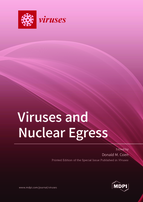Viruses and Nuclear Egress
A special issue of Viruses (ISSN 1999-4915). This special issue belongs to the section "Animal Viruses".
Deadline for manuscript submissions: closed (31 August 2021) | Viewed by 33020
Special Issue Editor
Interests: post-transcriptional regulation of gene expression relevant to virus latency; structure and function of viral DNA replication proteins; nuclear egress; and antiviral drug targets, drug mechanisms, and drug resistance
Special Issue Information
Dear Colleagues,
Virus nucleocapsids that assemble in the nucleus need a way to get into the cytoplasm. This fascinating process, known as nuclear egress, has been most deeply explored for herpesviruses. Herpesvirus nuclear egress includes movement of nucleocapsids to the nuclear periphery, disruption of the nuclear lamina, budding through the inner nuclear membrane, and fusion of the resulting enveloped particles with the outer nuclear membrane. Studies of nuclear egress can shed light on host cell nuclear functions, and abet discovery and understanding of antiviral drugs. Great strides have been made over the last two decades in understanding herpesvirus nuclear egress. Nevertheless, much remains to be learned regarding each of the steps of this process, and similar processes in other systems.
In this Special issue of Viruses, we seek research papers that contribute to our knowledge of nuclear egress and the viral and host proteins involved in this process in any virus or cellular system, or that communicate the discovery or understanding of antiviral compounds that target nuclear egress.
Prof. Dr. Donald M. Coen
Guest Editor
Manuscript Submission Information
Manuscripts should be submitted online at www.mdpi.com by registering and logging in to this website. Once you are registered, click here to go to the submission form. Manuscripts can be submitted until the deadline. All submissions that pass pre-check are peer-reviewed. Accepted papers will be published continuously in the journal (as soon as accepted) and will be listed together on the special issue website. Research articles, review articles as well as short communications are invited. For planned papers, a title and short abstract (about 100 words) can be sent to the Editorial Office for announcement on this website.
Submitted manuscripts should not have been published previously, nor be under consideration for publication elsewhere (except conference proceedings papers). All manuscripts are thoroughly refereed through a single-blind peer-review process. A guide for authors and other relevant information for submission of manuscripts is available on the Instructions for Authors page. Viruses is an international peer-reviewed open access monthly journal published by MDPI.
Please visit the Instructions for Authors page before submitting a manuscript. The Article Processing Charge (APC) for publication in this open access journal is 2600 CHF (Swiss Francs). Submitted papers should be well formatted and use good English. Authors may use MDPI's English editing service prior to publication or during author revisions.
Keywords
- nuclear egress
- herpesviruses
- nucleocapsids
- intranuclear movement
- nuclear lamina
- nuclear membranes
- budding
- envelope fusion
- antiviral drugs
- protein kinases







